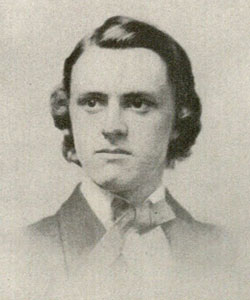James Kent Stone, 1867-1868
 James Kent Stone lived from November 10, 1840 to October 14, 1921, and was president at Kenyon from 1867 to 1868. In addition to his presidency, he was a faculty member in Latin language and literature (1862-67) and mental philosophy (1867-68).
James Kent Stone lived from November 10, 1840 to October 14, 1921, and was president at Kenyon from 1867 to 1868. In addition to his presidency, he was a faculty member in Latin language and literature (1862-67) and mental philosophy (1867-68).
Born in Boston, Massachusetts, on November 10, 1840, James Kent Stone was a son of Mary Kent Stone (1807-1901), daughter of jurist and legal scholar James Kent, and John Seely Stone (1795-1882), an Episcopal clergyman and author of numerous biographies and tracts. One of Kent Stone’s sisters, Elizabeth Kent Stone, would later become the wife of Kenyon alumnus Alexander Viets Griswold Allen (q.v.), another noted clergyman.
Stone graduated from Dixwell’s School in Boston and entered Harvard at the age of fifteen, although eye problems caused him to withdraw after a year and travel to Europe for treatment and a “rest cure.” During his time in Europe, he became expert in mountaineering, a then newly recognized sport he had enjoyed in childhood summers in New Hampshire. He set his sights on an ascent of Mount Blanc, which he accomplished in July 1857, along with his half- brother Archibald Morrison (q.v.), at the tender age of sixteen. As a result, he became the first American member of the Alpine Club, a society of English mountaineers.
Following his period of treatment in Europe, Stone returned to Harvard, graduating in 1861. He then pursued further studies at the University of Gottingen and in Italy. His undergraduate alma mater awarded him an M.A. in 1863.
Stone enlisted in the Second Massachusetts Volunteers in August 1862 for service in the Civil War. He fought at the Battle of Antietam but, suffering from a hernia, retired shortly thereafter. Although he enlisted as a private, he left the army as a second lieutenant.
In 1863, Stone joined the Kenyon faculty as an assistant professor of Latin language and literature. He became a deacon in the Episcopal church in 1863 and a presbyter in 1866. He was named to the College’s professorship in mental and moral philosophy in 1867, the same year he was elected to the presidency. At the age of twenty-seven, he became the youngest college chief executive in the nation.
The single year during which Stone was Kenyon’s president was among the most contentious in its history. Increasingly attracted to the Oxford Movement, which sought to reunite the Anglican (and, by extension, Episcopalian) and the Roman Catholic faiths, Stone ran afoul of the College’s prevailing “Low Church,” or evangelical, orthodoxy. He came to be seen as a dangerous heretic, not least because of his popularity among Kenyon students.
Stone left the College in 1868 after accepting the presidency of Hobart College, where his father had once taught. He stayed there less than a full year, during which he received an honorary doctorate in divinity from Racine College (an Episcopal institution that operated from 1852 to 1887), celebrated the birth of a third child, and mourned the death of his wife. He resigned from Hobart following its commencement of 1869. (Stone’s close friend Hamilton Smith [q.v.] left the Kenyon faculty to accompany him to Hobart. Smith remained there for the rest of his career.)
It was at this point that Stone made the momentous decision to become a Roman Catholic. He traveled to New York City and joined the Missionary Society of St. Paul, the Apostle, shortly after his departure from Hobart in 1869. A year later, he published The Invitation Heeded, which detailed his conversion and the call to become a Paulist.
In 1876, Stone became a member of the Order of the Passion and took the name Father Fidelis of the Cross. He spent a dozen years working for the order in South America, where he established new monasteries for the Passionists in both Argentina and Chile – necessitating frequent trips over the Andes or through the Straits of Magellan – as well as the Church of the Holy Cross in Buenos Aires.
Named consultor general of the Passionists in 1897, Stone lived in Rome while fulfilling that role. He later served the order in Cuba and then in California and Texas back in the United States. In the final years of his life, and especially after his death, he came to be known as “The American Newman” (for another famous convert to Roman Catholicism, the Englishman John Henry Newman).
Stone married Cornelia “Cornie” Fay at St. Paul’s Episcopal Church in Brookline, Massachusetts, on August 6, 1863, with the groom’s father presiding. The marriage produced three daughters - Cornelia, Ethel, and Sarah - before the death of Cornelia Fay Stone on February 6, 1869.
When Stone joined the Paulists, his daughters were sent to a Catholic boarding school in Manchester, New Hampshire. Ethel died there, after which Cornelia (later renamed Mary) and Sarah (renamed Frances) were adopted into the O’Connor family in San Rafael, California. Stone had no contact with his children from December 1869 until Frances O’Connor reached out to him after the publication of his book An Awakening: And What Followed in 1920.
Stone died on October 14, 1921, in San Mateo, California, with his two surviving daughters and a grandson at his side. Following a memorial service in Normandy, Missouri, his remains were interred in the Passionists’ private cemetery in St. Louis, Missouri.